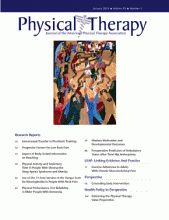Abstract
Background Despite increasing clinical and research use of the 11-item version of the Tampa Scale for Kinesiophobia (TSK-11) in people with neck pain, little is known about its measurement properties in this population.
Objective The purpose of this study was to rigorously evaluate the measurement properties of the TSK-11 when used in people with mechanical neck pain.
Design This study was a secondary analysis of 2 independent databases (N=235) of people with mechanical neck pain of primarily traumatic origin.
Methods The TSK-11 was subjected to Rasch analysis and subsequent evaluation of concurrent associations with the Neck Disability Index and a numeric rating scale for pain intensity.
Results The TSK-11 conformed well to the Rasch model for interval-level measurement, but less so for acute or nontraumatic etiologies. A transformation matrix suggested that small changes at the extremes of the scale are more meaningful than in the middle. Cross-sectional convergent validity testing suggested relationships of expected magnitude and direction compared with pain intensity and neck-related disability. The use of the linearly transformed TSK-11 led to potentially important differences in distribution of data compared with use of the raw scores.
Limitations The sample size was slightly smaller than desired for Rasch analysis. The 2 databases were similar in terms of symptom duration, but differed in pain intensity and age.
Conclusions The TSK-11 can be considered an interval-level measure when used in people with neck pain. It provides potentially important information regarding the nature of neck-related disability. Clinically important difference may not be consistent across the range of the scale.
Footnotes
Both authors provided concept/idea/research design, writing, data collection, and institutional liaisons. Dr Walton provided data analysis, project management, fund procurement, and facilities/equipment. Dr Elliott provided study participants and consultation (including review of manuscript before submission).
Some of the material contained in this report was given as a poster presentation at the 13th World Congress of the International Association for the Study of Pain; August 27–31, 2012; Milan, Italy.
Part of the data for this study were collected for a cohort study funded through the Physiotherapy Foundation of Canada. No funding was received specifically for the secondary analysis described in this report.
- Received June 15, 2012.
- Accepted September 4, 2012.












